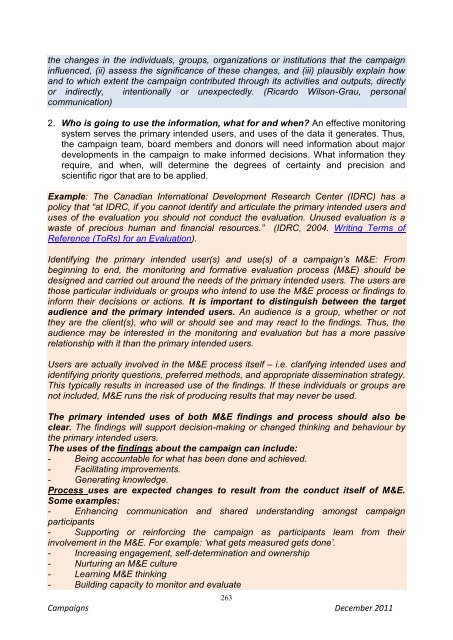Campaigns to End Violence against Women and Girls - Virtual ...
Campaigns to End Violence against Women and Girls - Virtual ...
Campaigns to End Violence against Women and Girls - Virtual ...
You also want an ePaper? Increase the reach of your titles
YUMPU automatically turns print PDFs into web optimized ePapers that Google loves.
the changes in the individuals, groups, organizations or institutions that the campaign<br />
influenced, (ii) assess the significance of these changes, <strong>and</strong> (iii) plausibly explain how<br />
<strong>and</strong> <strong>to</strong> which extent the campaign contributed through its activities <strong>and</strong> outputs, directly<br />
or indirectly, intentionally or unexpectedly. (Ricardo Wilson-Grau, personal<br />
communication)<br />
2. Who is going <strong>to</strong> use the information, what for <strong>and</strong> when? An effective moni<strong>to</strong>ring<br />
system serves the primary intended users, <strong>and</strong> uses of the data it generates. Thus,<br />
the campaign team, board members <strong>and</strong> donors will need information about major<br />
developments in the campaign <strong>to</strong> make informed decisions. What information they<br />
require, <strong>and</strong> when, will determine the degrees of certainty <strong>and</strong> precision <strong>and</strong><br />
scientific rigor that are <strong>to</strong> be applied.<br />
Example: The Canadian International Development Research Center (IDRC) has a<br />
policy that “at IDRC, if you cannot identify <strong>and</strong> articulate the primary intended users <strong>and</strong><br />
uses of the evaluation you should not conduct the evaluation. Unused evaluation is a<br />
waste of precious human <strong>and</strong> financial resources.” (IDRC, 2004. Writing Terms of<br />
Reference (ToRs) for an Evaluation).<br />
Identifying the primary intended user(s) <strong>and</strong> use(s) of a campaign’s M&E: From<br />
beginning <strong>to</strong> end, the moni<strong>to</strong>ring <strong>and</strong> formative evaluation process (M&E) should be<br />
designed <strong>and</strong> carried out around the needs of the primary intended users. The users are<br />
those particular individuals or groups who intend <strong>to</strong> use the M&E process or findings <strong>to</strong><br />
inform their decisions or actions. It is important <strong>to</strong> distinguish between the target<br />
audience <strong>and</strong> the primary intended users. An audience is a group, whether or not<br />
they are the client(s), who will or should see <strong>and</strong> may react <strong>to</strong> the findings. Thus, the<br />
audience may be interested in the moni<strong>to</strong>ring <strong>and</strong> evaluation but has a more passive<br />
relationship with it than the primary intended users.<br />
Users are actually involved in the M&E process itself – i.e. clarifying intended uses <strong>and</strong><br />
identifying priority questions, preferred methods, <strong>and</strong> appropriate dissemination strategy.<br />
This typically results in increased use of the findings. If these individuals or groups are<br />
not included, M&E runs the risk of producing results that may never be used.<br />
The primary intended uses of both M&E findings <strong>and</strong> process should also be<br />
clear. The findings will support decision-making or changed thinking <strong>and</strong> behaviour by<br />
the primary intended users.<br />
The uses of the findings about the campaign can include:<br />
- Being accountable for what has been done <strong>and</strong> achieved.<br />
- Facilitating improvements.<br />
- Generating knowledge.<br />
Process uses are expected changes <strong>to</strong> result from the conduct itself of M&E.<br />
Some examples:<br />
- Enhancing communication <strong>and</strong> shared underst<strong>and</strong>ing amongst campaign<br />
participants<br />
- Supporting or reinforcing the campaign as participants learn from their<br />
involvement in the M&E. For example: ‘what gets measured gets done’.<br />
- Increasing engagement, self-determination <strong>and</strong> ownership<br />
- Nurturing an M&E culture<br />
- Learning M&E thinking<br />
- Building capacity <strong>to</strong> moni<strong>to</strong>r <strong>and</strong> evaluate<br />
263<br />
<strong>Campaigns</strong> December 2011










